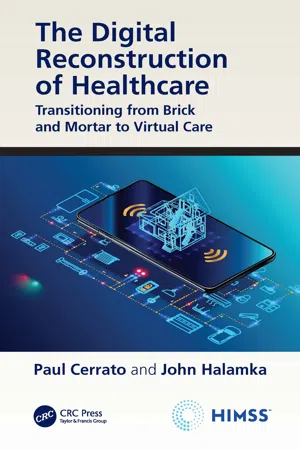
The Digital Reconstruction of Healthcare
Transitioning from Brick and Mortar to Virtual Care
- 150 pages
- English
- ePUB (mobile friendly)
- Available on iOS & Android
The Digital Reconstruction of Healthcare
Transitioning from Brick and Mortar to Virtual Care
About This Book
The complex challenges facing healthcare require innovative solutions that can make patient care more effective, easily available, and affordable. One such solution is the digital reconstruction of medicine that transitions much of patient care from hospitals, clinics, and offices to a variety of virtual settings. This reconstruction involves telemedicine, hospital-at-home services, mobile apps, remote sensing devices, clinical data analytics, and other cutting-edge technologies. The Digital Reconstruction of Healthcare: Transitioning from Brick and Mortar to Virtual Care takes a deep dive into these tools and how they can transform medicine to meet the unique needs of patients across the globe.
This book enables readers to peer into the very near future and prepare them for the opportunities afforded by the digital shift in healthcare. It is also a wake-up call to readers who are less than enthusiastic about these digital tools and helps them to realize the cost of ignoring these tools. It is written for a wide range of medical professionals including:
- Physicians, nurses, and entrepreneurs who want to understand how to use or develop digital products and services
-
- IT managers who need to fold these tools into existing computer networks at hospitals, clinics, and medical offices
-
- Healthcare executives who decide how to invest in these platforms and products
-
- Insurers who need to stay current on the latest trends and the evidence to support their cost effectiveness
Filled with insights from international experts, this book also features Dr. John Halamka's lessons learned from years of international consulting with government officials on digital health. It also taps into senior research analyst Paul Cerrato's expertise in AI, data analytics, and machine learning. Combining these lessons learned with an in-depth analysis of clinical informatics research, this book aims to separate hyped AI "solutions" from evidence-based digital tools. Together, these two pillars support the contention that these technologies can, in fact, help solve many of the seemingly intractable problems facing healthcare providers and patients.
Frequently asked questions
Information
Chapter 1 Is Digital Reconstruction Necessary?
- Are digital health initiatives effective?
- Is episodic healthcare meeting patients’ needs?
- How are healthcare needs being met in countries with a less-than-optimal healthcare infrastructure?
- Do we need a digitally enhanced clinical decision support system (CDSS) to address the of errors?
- Will the COVID-19 pandemic require more online solutions?
Reviewing the Evidence on Effectiveness
| Type | Definition of application | Examples of activities |
|---|---|---|
| Behavior Change Communication (BCC) or Social BCC | Provide health information and behavior change messages directly to clients or the general public and help link people with services. Message content may increase individuals’ knowledge or influence their attitudes and behaviors. |
|
| Information systems / Data collection | Increase the speed, reliability, quality, and accuracy of data collected through electronic methods and send to various levels of health system (district, state, national) for quicker analysis compared to paper-based systems. |
|
| Logistics / Supply management | Help track and manage commodities, prevent stock-outs, and facilitate equipment maintenance. Transmit information from lower- level to higher level health facility. |
|
| Service delivery | Support health worker performance related to diagnosis, treatment, disease management and referrals, as well as preventive services. Provide decision support to patients. |
|
| Financial transactions and incentives | Improve access to health services, expedite payments to providers and health services, and reduce cash-based operating costs. |
|
| Workforce development and support | Facilitate training and education, provider work planning and scheduling, supportive supervision, and human resource management. |
|
Note. Adapted from the Global Health Learning Center mHealth Basics, USAID (2014) and mHealth Compendium (2015) doi:10.1371 /journal.pone.0170581.t001 | ||
Table of contents
- Cover Page
- Half Title Page
- Title Page
- Copyright Page
- Dedication
- Table of Contents
- Preface
- Acknowledgments
- About the Authors
- Chapter 1: Is Digital Reconstruction Necessary?
- Chapter 2: The Merits and Limitations of Telemedicine, Hospital at Home, and Remote Patient Monitoring
- Chapter 3: The Digital Assault on COVID-19
- Chapter 4: Entering the Age of Big Data and AI-Assisted Medicine
- Chapter 5: Exploring the Artificial Intelligence/Machine Learning Toolbox
- Chapter 6: The Transformative Impact of Conversational Technologies
- Chapter 7: Securing the Future of Digital Health
- Chapter 8: The Digital Reconstruction of Global Health
- Index